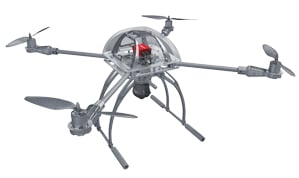What Microsoft Was for PCs, This Company Hopes to Be for Drones
Microsoft’s Windows operating system had a vital role in turning the personal computer into a ubiquitous technology. Jonathan Downey hopes his company Airware will play a similar part in the development of commercial drones.

The startup today launched a control system for drone makers to bundle with their small aircraft. It is intended to speed up the development of drone hardware and services that rely on drones, since it would free manufacturers or their customers from having to develop their own autopilots or flight planning software. Other companies will be able to build additional software to run on top of Airware’s system, adding features such as data collection options for a particular industry.
“For drones to be used for all the potential use cases, there needs to be a common platform,” says Downey. “This is the operating system for drones.” The craft are already in limited use in industries such as agriculture, mining, and moviemaking, and being tested for wilder ideas such as package or vaccine delivery. But commercial drones are still far from a fully established industry.
Airware’s product, the Aerial Information Platform, has three main components. One is a fist-sized box containing electronics and autopilot software that is installed on a drone to steer it. The second is a software package for PCs or tablets used to plan missions. A drone owner could, for example, click out a route on a map using this software. The third component is an online service to help companies manage their drone operations, letting them store past and future flight plans, flight logs, and data collected by drones such as photos. An annual subscription to Airware’s system costs $2,500 per vehicle (commercial drones often cost in the tens of thousands of dollars).
In a demonstration on a dairy farm in Sonoma County, California, on Tuesday, Airware’s software was used to fly helicopter-style drones with four and eight rotors, as well as a fixed-wing, airplane-style design. (However, the first version of the product won’t handle fixed-wing craft.)

French drone manufacturer Delta Drone is already using Airware’s system on aircraft used to inspect power lines and survey mining operations. Delta had previously developed its own autopilots and control software, but now won’t need to, says Christian Viguié, Delta Drone’s CEO. “I don’t want to continue to invest in that technology,” he says. “We want to develop strong expertise in how to help people use drones in their different industries.”
Delta’s customers include the multinational mining company Imerys, which uses drones to survey sites in France and South Africa, for example to measure the volume of rock that has been extracted.
GE, which invested in Airware late last year, is also using Airware’s technology to develop a service that will let utility companies use drones to inspect the structures that support power lines, says Alex Tepper, managing director for GE Ventures. Drone inspections of oil pipelines will likely be offered next, he says.
However, the ambitions of GE and many other potential Airware customers in the U.S. are limited by the Federal Aviation Administration, which is still working out the rules that will govern commercial drone flights. A draft version of the FAA rules, published in February to solicit industry feedback, included the restriction that commercial drones must remain within the line of site of their human operator. That rule, which does not exist in France and many other countries, would make inspecting long pipelines or large farms difficult and perhaps uneconomic.
Jesse Kalman, Airware’s director of business development and regulatory affairs, says his response to the FAA’s draft rules will argue that drones can be operated safely beyond line of sight. As evidence, he will point to an obstacle avoidance system developed by Airware and supported by the operating system released today. It allows a drone with a forward-looking camera to automatically change course if it sees something in its way.
Keep Reading
Most Popular
Large language models can do jaw-dropping things. But nobody knows exactly why.
And that's a problem. Figuring it out is one of the biggest scientific puzzles of our time and a crucial step towards controlling more powerful future models.
The problem with plug-in hybrids? Their drivers.
Plug-in hybrids are often sold as a transition to EVs, but new data from Europe shows we’re still underestimating the emissions they produce.
Google DeepMind’s new generative model makes Super Mario–like games from scratch
Genie learns how to control games by watching hours and hours of video. It could help train next-gen robots too.
How scientists traced a mysterious covid case back to six toilets
When wastewater surveillance turns into a hunt for a single infected individual, the ethics get tricky.
Stay connected
Get the latest updates from
MIT Technology Review
Discover special offers, top stories, upcoming events, and more.